
Yoga at Work: Simple Asanas During the Day
Our super hectic lives, juggling home and work, and tight schedules can play havoc with our body cycles. Especially if professional and personal commitments encroach on your exercise regimen. Most city folks have office jobs, since the past few years with the Covid 19 pandemic WFH or work from home, but all the work is essentially done sitting on a chair, at your desk.
Sitting for longer periods of time can be harmful for your health and can result in a number of medical problems such as obesity (especially extra fat in the waist region), elevated levels of cholesterol, high BP, diabetes. And not just physical health, staying stationery for longer durations has a detrimental effect on your mental wellbeing too. Our modern lifestyles are so centered around sitting in one place that sitting is considered the new smoking, it’s that hazardous to the overall health of people!
- About Yoga
Obviously work is important but so is your wellbeing, so finding that golden – mean to balance both is the key to maintaining good health. Yoga, the transformational spiritual science thousands of years old, codified by the great Sage Patanjali, concentrates on bringing about a harmony between the mind, body and the spirit by altering the energies in our bodies in a positive manner.
Sage Patanjali outlined ashtanga yoga sutras or the 8-fold path namely Yamas (abstinence), Niyamas (disciplines), Asana (postures), Pranayama (breath control), Pratyahara (withdrawal of senses), Dharana (concentration), Dhyana (meditation) and Samadhi (union with divinity).
Yoga asanas or physical postures are aimed at building stamina & strength, improving flexibility, balance & coordination, all with the intention of relaxing the mind and body.
- Ayurvedic Yoga
Ayurveda believes in a holistic concept of health that includes improving not just the physical but also the mental and spiritual aspects of an individual to ensure all round wellbeing. Similarly, Yoga is more than just physical postures (asanas) or breathing exercises (pranayama) and is one of the six main philosophies of the Vedic tradition which aims to bring awareness to the mind, body and spirit through the eight-fold path.
As Yoga and Ayurveda both come from ancient Vedic traditions they are complementary to each other. Ayurveda prescribed diet and lifestyle can support the Yoga practice by helping balance the vata, pitta and Kapha dosha nature of various yoga poses.
- A person who is Vata type should practice yoga asanas at a slow and smooth pace, hold the pose for a short duration but include repetitions, focus on prolonging their inhalation, stay connected to the ground/Prithvi, keep warm and not overexert themselves. Asanas that strengthen the lower back are best for vata dosha – Tadasana, Uttanasana, Ardha matsyendrasana, Apanasana, Paschimottanasana etc.
- A person who is Pitta type should practice yoga asanas in a relatively cooler place, mix up their routine and not stick to one sequence of asanas, focus more on their exhalations, include more asanas that give twists and side body workout and enjoy their yoga practice at a moderate pace. One of the most beneficial yoga practices for pitta dosha is pranayama or breathing control exercises. Forward bends or folds help cool the body which is necessary to balance pitta dosha. Asanas that do not heat up the body quickly should be included such as Anjaneyasana, Salabhasana, Uppavistakonasana, Ardha matsyendrasana etc.
- A person who is Kapha type should practice yoga asanas in a warm place at a quick pace and at high intensity, take strong & forceful breaths, keep the chest and shoulders open, pause a moment between inhalations & exhalations, take short breaks in between asanas, monitor their body alignment and keep moving. Yoga asanas that help overcome the dullness & sluggishness of kapha dosha and bring energy back should be included such as Surya namaskars, Natrajasana, Kapalbhati pranayama, Kundalini, Utarasana etc.
- Yoga at Work
Desk jobs don’t just reduce physical activity but also put a lot of strain on some vital body parts such as the back, neck and spine. That’s why getting up and moving about every 30 minutes from your place of work is recommended. But that by itself is not enough, this is where doing yoga poses at desk can be beneficial. Simple yoga asanas that can be easily done even in the office can provide a refreshing break and also prevent stressing out your body. Here are some easy yoga asanas that can help rejuvenate your organs & muscles, increase blood circulation, reduce stress levels and improve your overall health.
- Marjaryasana
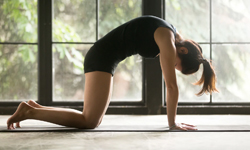 Also known as the cat pose, this asana stretches the spine, back muscles and the neck. It massages the abdomen area helping to improve digestion. Further, doing this asana also increases the spinal fluid circulation and stimulates blood flow in the wrist region.
Also known as the cat pose, this asana stretches the spine, back muscles and the neck. It massages the abdomen area helping to improve digestion. Further, doing this asana also increases the spinal fluid circulation and stimulates blood flow in the wrist region. - Anjaneyasana
 Known as the low lunge, Anjaneyasana is effective in stretching the hip, chest, quadriceps, waist, top of ankles & feet. Known to improve balance and focus. Especially useful asana if you have a desk job.
Known as the low lunge, Anjaneyasana is effective in stretching the hip, chest, quadriceps, waist, top of ankles & feet. Known to improve balance and focus. Especially useful asana if you have a desk job. - Veerabhadrasana
 As the name suggests, this asana is also called the warrior pose that helps stretch the chest, lungs, shoulders, inner thighs and the groin region. Very useful in strengthening the leg muscles, improving stamina and boosting concentration.
As the name suggests, this asana is also called the warrior pose that helps stretch the chest, lungs, shoulders, inner thighs and the groin region. Very useful in strengthening the leg muscles, improving stamina and boosting concentration. - Adhomukha shwanasana
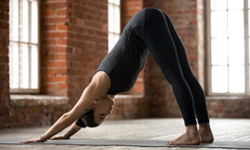 This asana pose resembles a downward facing dog and is effective in toning arms, legs and stabilizing he spine. Doing this asana helps improve the blood flow to the brain.
This asana pose resembles a downward facing dog and is effective in toning arms, legs and stabilizing he spine. Doing this asana helps improve the blood flow to the brain. - Tadasana
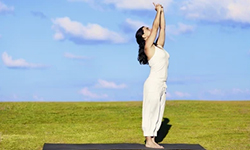 Popularly known as the mountain pose, Tadasana is a standing asana that is most useful in improving body posture and balance. Doing tadasana can help strengthen the lower body and also alleviate nerve pain in the legs (sciatica).
Popularly known as the mountain pose, Tadasana is a standing asana that is most useful in improving body posture and balance. Doing tadasana can help strengthen the lower body and also alleviate nerve pain in the legs (sciatica). - Setubandhanasana
 Setu literally means bridge and this asana, which resembles a bridge, primarily helps strengthen the back muscles. It is also known to reduce thyroid problems, improve lung capacity and digestion.
Setu literally means bridge and this asana, which resembles a bridge, primarily helps strengthen the back muscles. It is also known to reduce thyroid problems, improve lung capacity and digestion. - Trikonasana
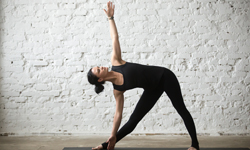 Trikon, a Sanskrit work, means Triangle. The asana is so named as it creates a body shaped triangle when done right. An almost full body pose, Trikonasana is highly effective in strengthening the back, torso and legs. It also helps stretch the inner thighs and sides, hamstring, calves, chest, spine, hips and shoulders of the body.
Trikon, a Sanskrit work, means Triangle. The asana is so named as it creates a body shaped triangle when done right. An almost full body pose, Trikonasana is highly effective in strengthening the back, torso and legs. It also helps stretch the inner thighs and sides, hamstring, calves, chest, spine, hips and shoulders of the body. - Vrikshasana
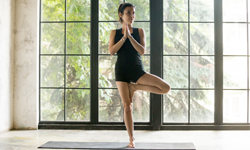 Vrikshasana or the tree pose (vriksha is Sanskrit for tree) is a body balancing asana and along with Tadasana is one of the few standing asanas in yoga. Most beneficial in creating an external rotation of the hips, it is also useful to strengthen the spine, legs and ankles. Vrikshasana assists in improving concentration and calms the mind.
Vrikshasana or the tree pose (vriksha is Sanskrit for tree) is a body balancing asana and along with Tadasana is one of the few standing asanas in yoga. Most beneficial in creating an external rotation of the hips, it is also useful to strengthen the spine, legs and ankles. Vrikshasana assists in improving concentration and calms the mind. - Salabhasana
 Salabhasana or the locust pose mainly strengthens the back and improves its flexibility while also helping stretch the front of the body. Useful in boosting stamina and stimulating the digestive organs.
Salabhasana or the locust pose mainly strengthens the back and improves its flexibility while also helping stretch the front of the body. Useful in boosting stamina and stimulating the digestive organs. - Gomukhasana
 Gomukh means the cow’s face. Gomukhasana helps open up the upper body parts such as the chest and shoulder region, stretches the upper back muscles and also gives a good workout to the triceps. Further, it also stretches the lower body organs such as the hips, thighs and ankles. While doing this asana almost all the body joints are in action, thus ensuring not just good posture but also improved blood circulation throughout the body.
Gomukh means the cow’s face. Gomukhasana helps open up the upper body parts such as the chest and shoulder region, stretches the upper back muscles and also gives a good workout to the triceps. Further, it also stretches the lower body organs such as the hips, thighs and ankles. While doing this asana almost all the body joints are in action, thus ensuring not just good posture but also improved blood circulation throughout the body.
- Marjaryasana
Long times spent sitting at your desk can result in bad posture, aggravate back problems and prevent proper blood circulation in the body. These easy yoga asanas are not only helpful in preventing all the aches & pains that come with lack of activity but are also time efficient (just doing each asana for around 4-5 minutes can make all the difference!) and can rejuvenate your mind, body and spirits.
Book your consultation with our experienced Ayurvedic Vaidya/health experts to get customized health plans and guidance on ayurvedic yoga.





0 Comment
No comments found.Thank you. Your comment will be visible after an approval.
Add your comment